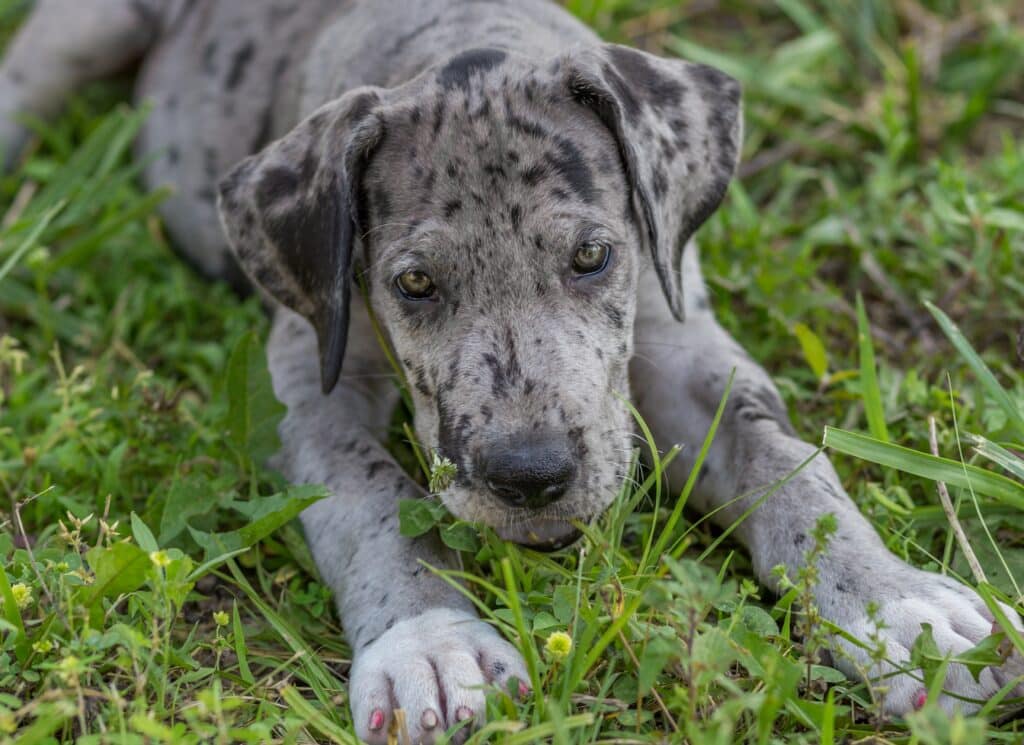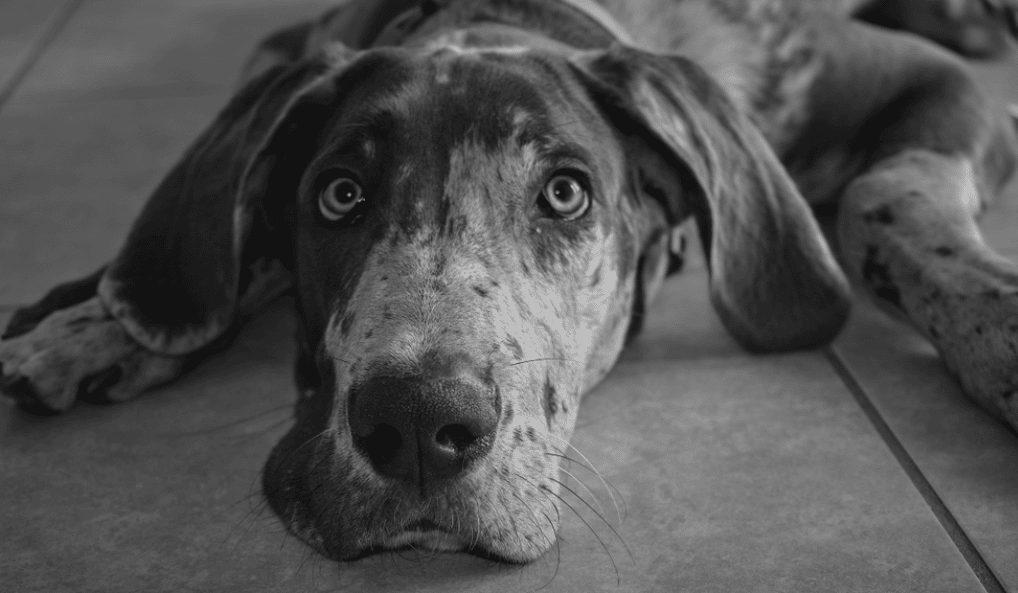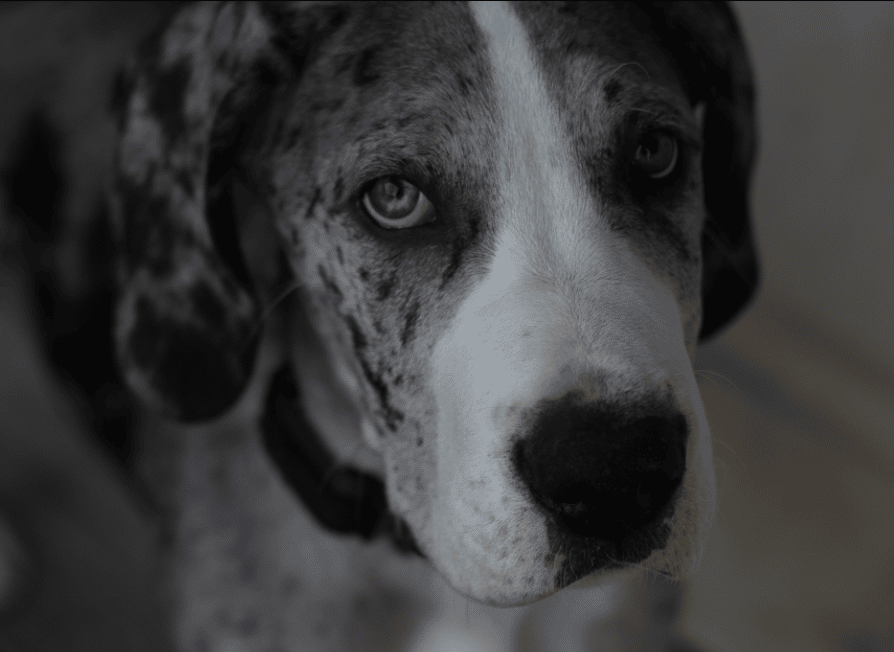“This post contains affiliate links, and I will be compensated if you make a purchase after clicking on my links.”
Last Updated on January 17, 2024
Blue Merle Great Danes are a a sight to behold. Although considered a “mismark”, they are quite impressive in their own right!
These gentle giants are generally grouped together with Merle Danes. And while some advertise them as “rare” Danes, they are actually quite common in Harlequin Dane litters.
In this article, we’ll tell you everything you need to know about these exquisitely majestic dogs!
Blue Merle Great Dane Appearance

A Blue Merle Great Dane appears to have a brownish blue or dark blue base coat color with dark blue spots. The spots around their body may appear black due to their already dark base coat.
Furthermore, their nose’s pigmentation appear to have a bluish black color. This is actually the easiest way to identify a Blue Merle. Because their nose doesn’t have the usual pink, brown or black pigmentation that other Danes have.
And the same goes for their paw pads! Blue Merle Danes’ paw pads are also blue in color.
While they are generally grouped together with Merle Great Danes, Blue Merles are common in Harlequin litters, and are therefore, a mismark of the Harlequin coat.
Blue Merle Great Danes As “Mismarks”
Blue Merle Great Danes are mismarks. Being a mismark means that the American Kennel Club (AKC) does not recognize this coat color as a standard Great Dane color and it does not adhere to breed standards.
But it is worth taking note that AKC and their standards are only relevant if you want to have a show dog and join conformations.
However, if you want a family companion, then a Blue Merle Great Dane is as good as any standard Great Dane.
Blue Merle Great Danes Are Not Rare
Many breeders claim that Blue Merle Great Danes are rare, and therefore price their pups higher. However, this is not true. Blue Merles are NOT rare at all and are pretty common. As a matter of fact, they are a frequently occurring pattern in the Great Dane breed.
Silver vs Blue Merle Great Dane
Silver Merle and Blue Merle Danes almost look the same. But the best way to differentiate the two is by looking at the color of their noses.
A Silver Merle Great Dane’s nose is commonly solid black. And once in a while, it can also be pink in color. Meanwhile, as mentioned above, a Blue Merle Great Dane’s nose always has a bluish black color.
Another way to differentiate the two is by looking at the color of the spots around their body. A Silver Merle’s spots are black, while a Blue Merle’s are dark blue.
Breeding

We are confident that a lot of Blue Merle Great Danes grow up to be gentle giants with amazing conformation, characteristics, and everything in between that makes any other Great Dane wonderful and loveable.
However, breeding Blue Merle Great Danes with another Merle Dane is considered unethical by the Great Dane Club of America’s Breeder’s Code of Ethics.
This is because breeding two Great Danes that carry the Merle gene increases the chances of producing “Double Merles”.
These Double Merles are usually born with a lot of health problems, such as being born blind and/or deaf, and having life-threatening issues such as skin cancer.
Furthermore, there is a higher risk for stillborn puppies from Merle x Merle breeding.
Furthermore, breeding a Merle and a Harlequin together can also produce Double Merles in a litter because Harlequin Danes carry the Merle gene. So, this is also a no-no!
Avoiding Merle Great Dane Breeding
The intentional Blue Merle or Merle Great Dane breeding must be avoided. Trustworthy and knowledgeable Great Dane dog breeders avoid the deliberate Merle or Blue Merle Great Dane breeding due to the troubles it may cause.
Health Concerns
Blue Merle Great Danes are like any other Merle Great Dane. On top of the health problems that the breed is predisposed to, Blue Merles can can also suffer from the following:
- Blindness
- Deafness
- Skin problems
- Behavioral issue like aggression
Our Recommendations
While it is true that Blue Merle Great Danes are mismarks, they can still grow healthy and become amazing dogs just like any other Dane!
The AKC may not recognize them because they are not up to the breed’s standard, but that doesn’t mean they’re anything less than amazing and beautiful.
And if you own one and want to enjoy a life with a beautiful companion, consider neutering or spaying them for a longer life.
Furthermore, never buy Blue Merle Great Danes from unethical breeders that sell them at a higher price and call them “rare”. And since they carry the Merle gene, make sure to never intentionally breed them with other Danes that carry the same gene.

I have a blue Merle Great Dane and a fawn Great Dane but my fawn Great Dane is like twice the size of the Merle and she’s almost 2 how is that?
As broached in the article, the Blue Merle Great Dane might not be a healthy dog. While Fawn, being a Standard Great Dane canine holds one of the finest genes of the breed. Therefore, your Fawn Great Dane has optimal growth whilst the Blue Merle Dane is lagging behind.
I have a beautiful, completely healthy, 10 out of 10 per 3 separate vets, hearing, seeing, functioning, very intelligent, house broken, crate trained, successfully trained to obey several voice commands and 3 hand commands, Blue Merle @20 weeks and counting. Weighs in at 65lbs and growing. We have found no health concerns whatsoever.